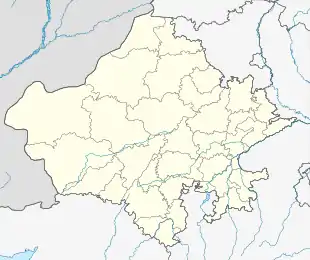Pokhran
Pokhran is a village and a municipality located in the Jaisalmer district of the Indian state of Rajasthan. It is a remote location in the Thar Desert region and served as the test site for India's first underground nuclear weapon, ballistic missiles.
Pokhran | |
|---|---|
City | |
 Pokhran Fort | |
 Pokhran  Pokhran | |
| Coordinates: 26.92°N 71.92°E | |
| State | |
| State | Rajasthan |
| District | Jaisalmer |
| Elevation | 233 m (764 ft) |
| Population (2011) | |
| • Total | 28,457 |
| Languages | |
| • Official | Hindi |
| Time zone | UTC+5:30 (IST) |
Geography
Surrounded by rocks, sand and five salt ranges, its Hindi name Pokhran (पोखरण) means "palace of five mirages". It is located en route between Jaisalmer and Jodhpur or Bikaner at 27.095°N 71.753°E and has an average elevation of 233 metres (764 feet).
History
Fort Pokran
Fort Pokhran, the 14th century citadel also known as "Balagarh", stands amidst the Thar Desert. This monument is the premier fort of the chief of the rathore, the clan of Rathores of the state of Marwar-Jodhpur. Fort Pokhran is open for visitors and is being currently run as heritage hotel by the royal family of Pokhran.
Shakti Mata Memorial
In the outskirts of the city, the [Shakti Mata Memorial], a royal cenotaph, is freely accessible.
The famous, touristic city and fort of Jaisalmer is a couple of hours away by road.
Former rulers
- Seat of Chief of the Rathores, a sub-clan of Rathores of the state of Marwar-Jodhpur.
- Bhawani Singh of Pokhran (b. 1911) was the last jagirdar of Pokhran before Indian independence. He was Sessions Judge and was elected to the 1st Lok Sabha, the Lower house of Indian parliament from Barmer-Jalore constituency, after getting elected as an Independent candidate in the 1952 Indian general election.[1][2]
Demographics
According to 2011 Indian census,[3] Pokhran had a population of 28457. Males constitute 55% of the population and females 45%. Pokhran has an average literacy rate of 56%, lower than the national average of 74.0%: male literacy is 68%, and female literacy is 41%. In Pokhran, 19% of the population is under 6 years of age.
Pokhran Nuclear Test Range
| Pokhran Test Range (PTR) | |
|---|---|
| Near Jaisalmer in India | |
| Coordinates | 27.095°N 71.753°E |
| Type | Nuclear test site |
| Site information | |
| Operator | |
| Status | active |
| Site history | |
| In use | 1970–present |
| Test information | |
| Subcritical tests | not known |
| Nuclear tests | 6 |
The Pokhran Test Range, a key component of India's nuclear programme, is located in the municipality. The Indian Nuclear Test Site is located 45 km north-west of Pokhran town and 4 km north of Khetolai village.[4] The test range was built by the Indian Army Corps of Engineers and is under the control of Indian Army. It was built sometime before May 1974, when, following authorization given to the Bhabha Atomic Research Centre by then-Prime Minister Indira Gandhi, it hosted the detonation of India's first nuclear device.
Pokhran-I
The Ministry of External Affairs designated the test "Pokhran-I", but it is also known as "Smiling Buddha". It was India's first successful nuclear bomb test on 18 May 1974.[5][6] The bomb was detonated on the army base Pokhran Test Range (PTR), in Rajasthan, by the Indian Army under the supervision of several key Indian generals.
Pokhran-II
On 11 and 13 May 1998, twenty-four years after Pokhran-I, the Indian Defence Research and Development Organisation (DRDO) and Atomic Energy Commission (AEC) conducted five further nuclear tests, dubbed "Pokhran-II", at the Pokhran range. Four AEC devices and, under the codename Shakti, a thermonuclear device were tested.
See also
- Bhaniyana
- Jajwala Mata Temple
- Parmanu: The Story of Pokhran - a 2018 Bollywood movie.
References
- Soszynski, Henry. "Pokhran (thikana) Genealogy". Archived from the original on 22 December 2015. Retrieved 24 June 2014.
- "Members Bioprofile: First Lok Sabha". Lok Sabha website. Archived from the original on 24 June 2014. Retrieved 24 June 2014.
- "Census of India 2001: Data from the 2001 Census, including cities, villages and towns (Provisional)". Census Commission of India. Archived from the original on 16 June 2004. Retrieved 1 November 2008.
- Forty years after Pokhran nuclear tests, villagers complain of frequent cancer deaths, Scroll.in, 18 May 2014
- FIles. "1974 Nuclear files". Nuclear Age Peace Foundation. Nuclear files archives. Retrieved 14 January 2013.
- "Smiling Buddha, 1974". India's Nuclear Weapons Program. Nuclear Weapon Archive.
